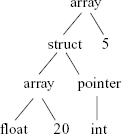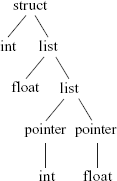6.2 Type Expressions and Type Constructors
One obvious way of representing a complex data type is to show how it is arrived at by means of a tree structure. For example, consider the following declarations and definition.
int a[100];
This can be represented by a tree as:
struct my {
float f[20];
int *pi;
} b[5];
This array of struct definition can be represented by a tree as:

Usually, a complex data type is constructed by the following methods or their combination:
Pointers: have a single component of type T, the type of construct is a pointer to T.
Arrays: have two components – type of array elements T (left child) and number of elements (right child).
Structures (Records): have one component (child) for each field in the structure, in the left-to-right order in which they appear in the structure.
Functions: have two components (children) – the type of the returned value and the list of types of arguments.
Unions: similar to structures.
It will be desirable to construct these type trees as Binary trees, but here we face a problem – in general a structure can have more than two fields and a function could have more than one argument. We must have a way of representing more than two children in a Binary tree. This can be done as follows. Suppose we have a function with 3 arguments:
int func1(float a, int *b, float *c);
We can represent this by a tree such as:

A function without arguments will be represented by a tree such as:

A type tree for a structure with more than two fields be similarly constructed.
For example:

represents a struct with four fields:
struct four {
int i;
float f;
int *pi;
float *pf;
}
Though the Node structure we have suggested previously can easily be used for representing a non-Binary tree, we are still interested in Binary type tree, as we already have in our Scanner functions for Binary tree manipulations like insert node, look-up node, traverse, etc.
In the Symbol Table, we should be able to refer to a type tree instead of a simple type. First, we define additional types:
#define INT 274
#define NUMBER 258
#define STRING 259
#define VAR 261
#define IVAR 275
#define SVAR 276
#define FUNCTION 268
#define PROCEDURE 269
#define TREE 1000
#define POINTER TREE+1
#define ARRAY TREE+2
#define STRUCT TREE+3
#define UNION TREE+4
#define FUNCDEF TREE+5
#define LIST TREE+10
Note that all the structuring types have assigned values greater than TREE = 1000. Type TREE is simply used in code to decide if we have a complex type definition.
We now redefine the interpretation of various fields in the Node structure as follows:
typedef union{
struct node_struct*N;
char*S;
long I;
float F;
void *P;
}util;
typedef struct node_struct{
struct node_struct *link[2]; // left = link[0], right = link[1]
util u,v,w,x,y,z;
}Node;
#define L(n) ((n)–>link[0])
#define R(n) ((n)–>link[1]) |
#define left(n) L(n) | Basic Symbol Table
#define right(n) R(n) |
#define name(n) ((n)–>w.S) /
#define type(n) ((n)–>v.I) ––+ Types:
| if > TREE than a constructor
#define ttree(n) ((n)–>z.N) <–+ tree at this pointer
Other fields in the Node are used for other purposes and not of concern here.
